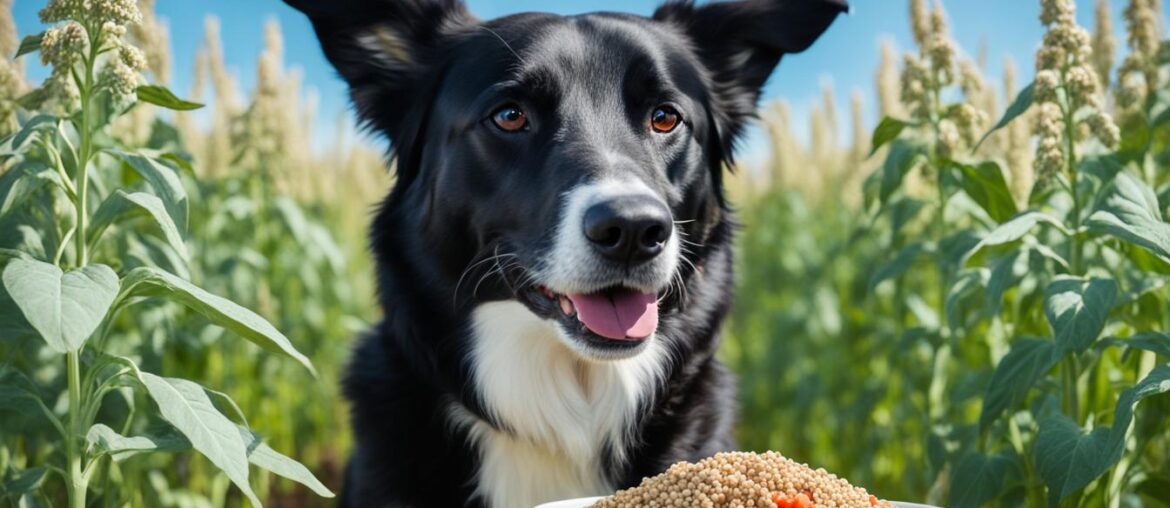As a dog owner, I want the best for my furry friend, including a healthy diet. Recently, I’ve been hearing a lot about quinoa and its potential benefits for dogs. But before I jump on the quinoa bandwagon, I want to know the truth. Is quinoa really good for dogs? Can dogs eat quinoa safely? And what are the health benefits of including quinoa in their diet?
To answer these questions, I’ve done extensive research on the topic. In this article, I will share with you everything you need to know about quinoa and its relationship with our canine companions. From its nutritional value to the proper way of incorporating it into their diet, we’ll cover it all!
So, if you’ve ever wondered about feeding your dog quinoa or if you’re looking for ways to enhance their diet with this nutritious grain, you’ve come to the right place. Read on to discover the truth behind quinoa for dogs and how it can contribute to their overall health and well-being.
Key Takeaways:
- Quinoa can be a beneficial addition to a dog’s diet, providing essential nutrients.
- It should not replace meat as the main source of nutrition.
- Properly cooked and prepared quinoa is safe for dogs to eat.
- Quinoa is a good source of protein, fiber, vitamins, and minerals for dogs.
- Consult with a veterinarian to determine the appropriate amount of quinoa for your dog.
Can Dogs Eat Quinoa?

Quinoa is safe for dogs to eat, as long as it is properly cooked and prepared. This gluten-free seed can be a healthy alternative to other carbohydrate sources found in dog food, providing various benefits for our furry friends.
Quinoa Safety for Dogs
When feeding quinoa to dogs, it is essential to ensure that it is cooked thoroughly to make it easily digestible. Undercooked quinoa may cause digestive issues and discomfort in dogs. It is also important to note that some dogs may have difficulty digesting quinoa, leading to vomiting, diarrhea, or constipation. If your dog experiences any of these symptoms after consuming quinoa, it’s best to avoid feeding it in the future.
Quinoa Benefits for Dogs
While dogs are primarily carnivores, adding quinoa to their diet can offer additional nutrients and benefits. Quinoa is a good source of protein, fiber, and various vitamins and minerals, making it a nutritious choice for dogs. It can contribute to their overall well-being, supporting their immune system, digestion, and energy levels.
Moreover, quinoa is low in calories, gluten-free, and free from common allergens, making it suitable for dogs with specific dietary restrictions or sensitivities.
How to Safely Incorporate Quinoa into Your Dog’s Diet
Before introducing quinoa to your dog’s diet, it is always recommended to consult with your veterinarian to ensure it is suitable for your dog’s specific health needs and dietary requirements.
If your dog tolerates quinoa well and does not show any adverse reactions, you can incorporate it into their diet in various ways. Here are a few ideas:
- Mix cooked quinoa with your dog’s regular food to add nutritional variety.
- Use cooked quinoa as a nutritious topping for your dog’s meals.
- Include quinoa in homemade dog treats, using dog-friendly recipes.
Can Dogs Eat Quinoa? Quinoa Safety for Dogs – Table
| Benefits of Quinoa for Dogs: | Considerations: |
|---|---|
| Good source of protein | Monitor for any adverse reactions |
| Rich in fiber | Avoid feeding undercooked quinoa |
| Provides essential vitamins and minerals | Consult with a veterinarian before introducing quinoa |
| Low in calories and gluten-free | Ensure proper cooking and preparation |
Remember, while quinoa can be a healthy addition to your dog’s diet, it should not replace meat as the main source of nutrition. Variety is key, and a balanced diet that includes appropriate proportions of protein, carbohydrates, and fats is crucial for your dog’s optimal health.
Health Benefits of Quinoa for Dogs
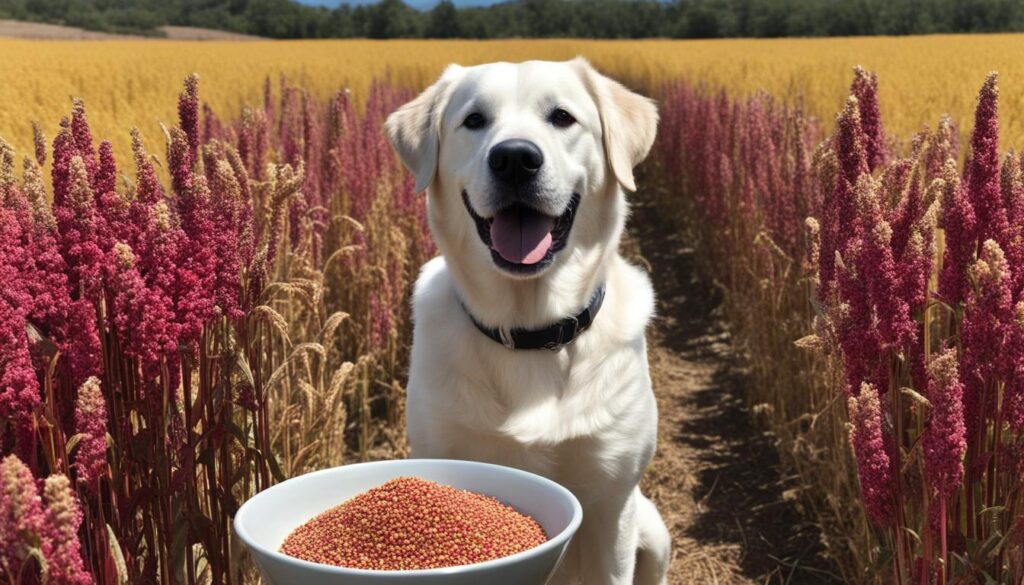
Quinoa is a nutrient-rich superfood that offers several health benefits for dogs. It is an excellent source of protein, fiber, vitamins, and minerals, making it a valuable addition to their diet.
One of the key health benefits of quinoa for dogs is its protein content. Protein is essential for supporting a dog’s overall health, including muscle development, immune system function, and tissue repair. Quinoa contains all nine essential amino acids, making it a complete protein source.
Fiber is another important component of quinoa that contributes to a dog’s digestive health. It aids in proper digestion, helps regulate bowel movements, and can prevent constipation. Additionally, the fiber content in quinoa promotes a feeling of fullness, which can support weight management in dogs.
Quinoa is also rich in essential vitamins and minerals, including magnesium, iron, and zinc. These nutrients play vital roles in various biological functions, such as oxygen transport, immune system support, and cell growth and repair.
Furthermore, quinoa provides dogs with a steady supply of clean energy due to its stable carbohydrate content. Unlike refined carbohydrates, such as white rice or wheat, quinoa is a complex carbohydrate that releases energy slowly, preventing blood sugar spikes and crashes in dogs.
Moreover, quinoa is gluten-free, which is beneficial for dogs with food sensitivities or allergies. It is also low in calories, making it a healthy option for weight-conscious dogs or those prone to obesity.
Summary of Health Benefits:
- High in protein, supporting muscle development and immune system function
- Rich in fiber, promoting healthy digestion and weight management
- Packed with essential vitamins and minerals for overall health
- Provides clean energy with stable carbohydrate content
- Gluten-free and low in calories, suitable for dogs with sensitivities or weight concerns
Incorporating quinoa into your dog’s diet can be a great way to enhance their nutritional intake, but it should be done in moderation and alongside a balanced diet. As with any dietary changes, it is important to consult with a veterinarian to ensure that quinoa is suitable for your dog and to determine the appropriate serving size.
| Nutrient | Amount per 100g of Cooked Quinoa |
|---|---|
| Protein | 4.4g |
| Dietary Fiber | 2.6g |
| Magnesium | 32mg |
| Iron | 1.5mg |
| Zinc | 1.1mg |
Incorporating Quinoa into a Dog’s Diet
Quinoa can be a wonderful addition to a dog’s diet, providing them with a range of nutritional benefits. There are several ways in which you can incorporate quinoa into your dog’s meals, ensuring that they receive all the goodness this grain has to offer.
Mixing Quinoa with Regular Food
One simple way to incorporate quinoa into your dog’s diet is by cooking it and mixing it with their regular food. You can prepare quinoa as you would for yourself, ensuring that it is fully cooked and cooled before adding it to your dog’s bowl. Mixing it with their regular food can add variety to their meals and introduce them to new flavors.
Using Quinoa as a Topping
Another option is to use quinoa as a topping for your dog’s meals. After cooking and cooling the quinoa, you can sprinkle it over their food as a healthy and nutritious addition. This can provide texture and a pleasant crunch to their meal while increasing the nutritional value.
Including Quinoa in Homemade Dog Treats
If you enjoy baking for your furry friend, you can incorporate quinoa into homemade dog treats. There are many dog-friendly quinoa recipes available that ensure the proper cooking and preparation of quinoa for dogs. From biscuits to bars, incorporating quinoa into treats can be a great way to give your dog an extra boost of nutrients.
“Quinoa is a versatile ingredient that can be added to a dog’s diet in various ways, providing them with essential nutrients and variety in their meals.”
Remember, when introducing quinoa to your dog’s diet, it’s important to start gradually and monitor their reaction. Some dogs may tolerate quinoa well, while others may experience digestive issues. If you notice any adverse reactions such as vomiting, diarrhea, or constipation, discontinue feeding quinoa and consult with a veterinarian.
By incorporating quinoa into your dog’s diet in these different ways, you can provide them with the nutritional benefits of this superfood. Keep in mind that quinoa should complement their regular food and not replace the necessary protein and nutrients obtained from a balanced canine diet.
| Ways to Incorporate Quinoa into a Dog’s Diet | Benefits |
|---|---|
| Mixing quinoa with regular food | – Adds variety to meals – Introduces new flavors |
| Using quinoa as a topping | – Adds texture and crunch – Increases nutritional value |
| Including quinoa in homemade dog treats | – Provides essential nutrients – Offers a healthy snack option |
Experimenting with different ways to incorporate quinoa into your dog’s diet can help keep their meals exciting and nutritious. Just remember to consult with a veterinarian before making any significant changes to your dog’s diet, and always prioritize their individual needs and preferences.
Quinoa vs. Rice for Dogs
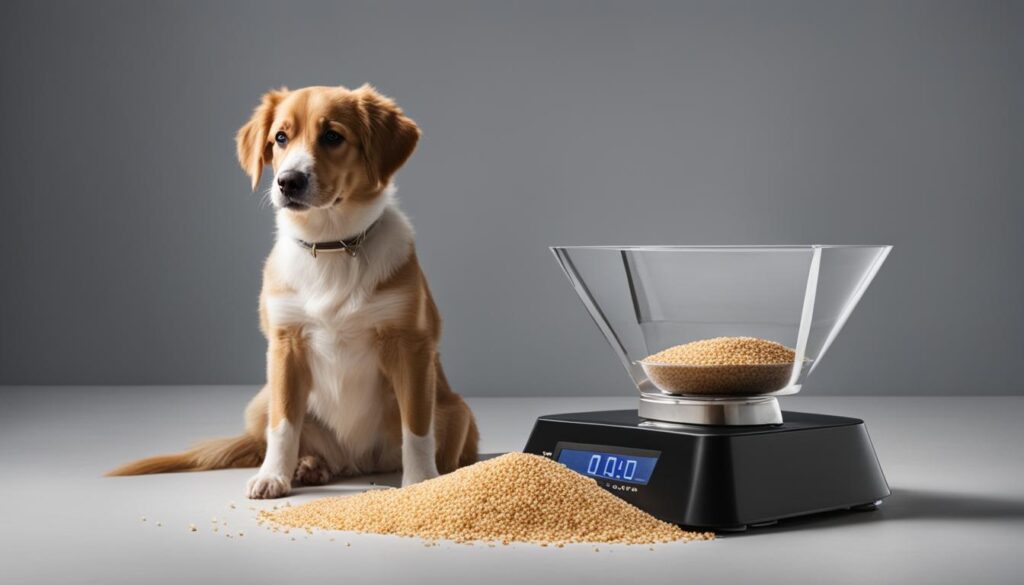
When it comes to choosing between quinoa and rice for your dog, there is no clear-cut winner. Both quinoa and rice offer nutritional benefits and can be included in a balanced diet for dogs. The decision ultimately depends on your dog’s individual needs and preferences. Consulting with a veterinarian will help you make an informed choice that suits your furry friend’s dietary requirements.
Quinoa is known for its high protein content and is considered a complete protein, meaning it contains all essential amino acids. It also provides fiber and various vitamins and minerals that contribute to overall canine health. On the other hand, rice is easily digestible and can be a gentle option for dogs with sensitive stomachs.
Some dogs may have specific dietary requirements, such as those with certain allergies or sensitivities. In these cases, one grain may be better tolerated than the other. For example, dogs with gluten sensitivity may benefit from quinoa, which is naturally gluten-free.
Ultimately, the best approach is to assess your dog’s specific needs and work with your veterinarian to determine the most suitable grain for them. Together, you can tailor their diet to ensure they receive the necessary nutrients while accounting for any dietary restrictions or sensitivities they may have.
- Both quinoa and rice have their own nutritional benefits for dogs.
- The choice between the two depends on your dog’s needs and preferences.
- Consulting with a veterinarian is crucial in making the right decision.
How Much Quinoa Can Dogs Have?
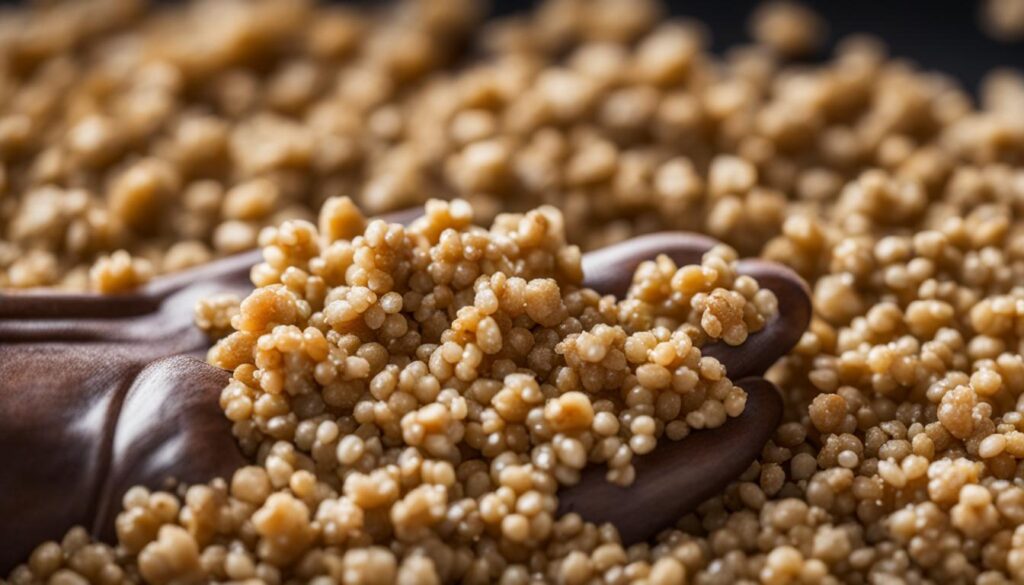
The amount of quinoa that a dog can have can vary depending on several factors, including their size, age, and activity level. It is important to consider these factors to ensure that your dog receives the appropriate amount of quinoa in their diet.
When introducing quinoa to your dog’s diet, it is recommended to start with a small amount and gradually increase the serving size over time. This allows their digestive system to adjust and minimizes the risk of any adverse effects.
Monitoring your dog’s reaction is crucial when feeding them quinoa. Watch for any signs of discomfort or digestive issues such as vomiting, diarrhea, or constipation. If you notice any adverse effects, it is best to consult with a veterinarian for guidance.
Remember, quinoa should not be the sole source of nutrition for your dog. It is essential to maintain a balanced diet that includes other appropriate foods like meat, as dogs are primarily carnivores. Quinoa can be a healthy addition to their diet, but it should be part of a well-rounded meal plan.
Quinoa Serving Size Guidelines for Dogs
Here are some general serving size guidelines to consider when feeding quinoa to your dog:
- Small dogs: Start with 1-2 tablespoons of cooked quinoa and gradually increase to no more than ¼ cup per day.
- Medium dogs: Begin with ¼ cup of cooked quinoa and gradually increase to a maximum of ½ cup per day.
- Large dogs: Start with ½ cup of cooked quinoa and gradually increase to no more than 1 cup per day.
It’s important to note that these are general recommendations, and individual dogs may have different needs. Always consider your dog’s specific requirements and consult with a veterinarian to determine the appropriate serving size for your furry friend.
Providing your dog with the right amount of quinoa will ensure they can enjoy its nutritional benefits without any negative effects. Remember to prioritize a balanced diet and consult with a professional for personalized advice.
Considerations When Feeding Quinoa to Dogs
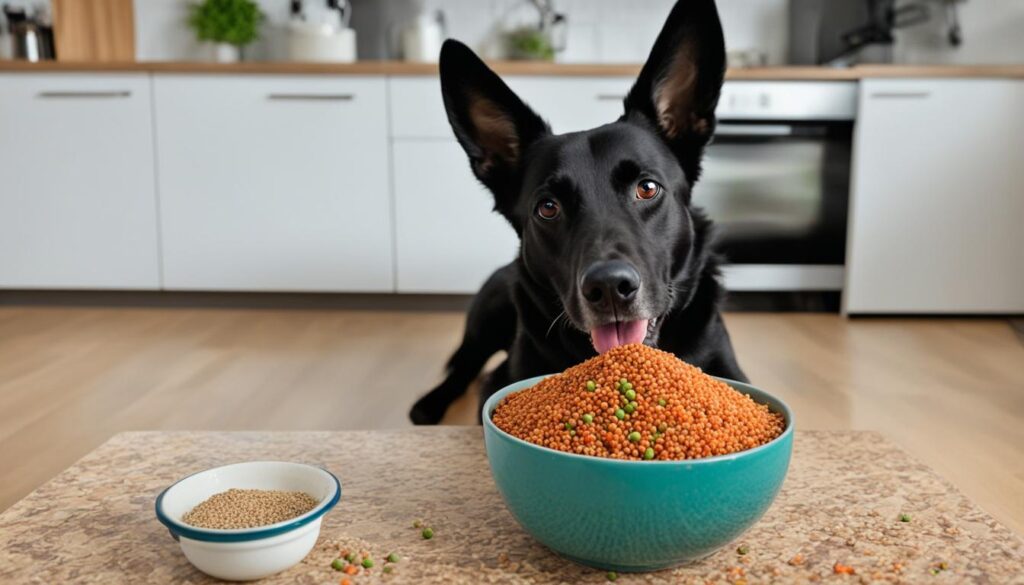
When it comes to feeding quinoa to dogs, there are a few important considerations to keep in mind. Firstly, it is crucial to ensure that the quinoa is properly cooked and prepared. Dogs should only be given cooked quinoa, as raw quinoa can be difficult for them to digest.
It is also essential to avoid feeding dogs seasoned quinoa that contains ingredients such as garlic and onion. These ingredients can be toxic to dogs and should be avoided at all costs. Stick to plain, unseasoned quinoa when adding it to your dog’s diet.
Another important point to note is that while quinoa can be a healthy addition to a dog’s diet, it should not be the sole source of nutrition. Dogs are primarily carnivores and require a diet rich in animal protein. Quinoa should be used as a supplement or added as a small portion of their overall meal.
Additionally, it’s worth mentioning that other grains, such as brown rice, can also be included in a dog’s diet in moderation. Brown rice is a good source of carbohydrates and can provide additional variety in their meals. However, it’s important to consult with your veterinarian before making any significant changes to your dog’s diet.
Remember, every dog is different, and their dietary needs may vary. If you have any concerns or questions about feeding quinoa to your dog, it’s best to seek guidance from a qualified veterinarian.
Quinoa vs. Brown Rice for Dogs
| Quinoa | Brown Rice |
|---|---|
| Rich in protein, fiber, and essential nutrients | Good source of carbohydrates |
| Gluten-free | Gluten-free |
| Low in calories | Low in calories |
| Complete protein with all nine essential amino acids | Does not provide complete protein |
What Human Foods Can Dogs Eat?
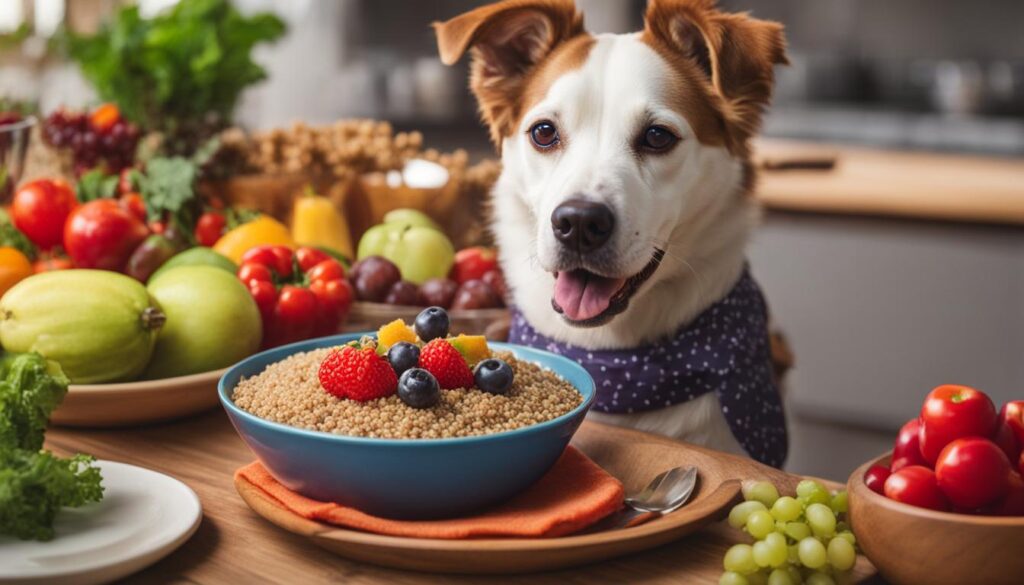
Dogs can safely consume a variety of human foods, including plain non-processed meats, fish, vegetables, and fruits. However, not all human foods are healthy for dogs, and it is important to be aware of foods that are toxic or can cause gastrointestinal issues. It is best to consult with a veterinarian and do proper research before introducing human food into a dog’s diet.
Foods Safe for Dogs:
- Plain cooked chicken or turkey
- Salmon or tuna (cooked and boneless)
- Carrots, green beans, and peas (cooked and cut into small pieces)
- Apples, bananas, and strawberries (sliced or mashed)
Foods to Avoid:
- Chocolate
- Grapes and raisins
- Onions and garlic
- Avocado
- Xylitol (found in some sugar-free gums and candies)
It’s important to remember that every dog is different and may have specific dietary restrictions or allergies. Always consult with a veterinarian before introducing new foods into your dog’s diet.
| Foods Safe for Dogs | Foods to Avoid |
|---|---|
| Plain cooked chicken or turkey | Chocolate |
| Salmon or tuna (cooked and boneless) | Grapes and raisins |
| Carrots, green beans, and peas (cooked and cut into small pieces) | Onions and garlic |
| Apples, bananas, and strawberries (sliced or mashed) | Avocado |
| Xylitol (found in some sugar-free gums and candies) |
Commercial Dog Food vs. Human-Grade Dog Food
When it comes to choosing the best food for our beloved furry friends, the options can be overwhelming. With so many different brands and types of dog food available, it can be challenging to determine what is truly best for our dogs. One important consideration is the quality of the ingredients used and the standards set in the production process. This is where the comparison between commercial dog food and human-grade dog food becomes crucial.
Commercial dog food, while convenient, often contains questionable ingredients that may not be ideal for our dogs’ overall health. These ingredients can include fillers, by-products, artificial preservatives, and low-quality meats. Additionally, commercial dog food may not be subject to strict government regulations, which means the quality and safety of the ingredients may vary.
On the other hand, human-grade dog food meets higher standards and is produced with ingredients that are safe for human consumption. Human-grade dog food manufacturers often use high-quality, human-grade ingredients, which means that the ingredients are of a higher quality compared to those found in commercial dog food. These foods are often made in certified kitchens and follow strict quality control measures to ensure the safety and nutritional value of the food.
The benefits of feeding our dogs human-grade dog food are numerous. Not only does it provide them with higher-quality ingredients, but it also offers peace of mind knowing that the food they are consuming is held to the same standards as the food we eat ourselves. Human-grade dog food is often nutritionally balanced and can contribute to improved digestion, healthier skin and coat, increased energy levels, and overall better health.
While it is true that feeding dogs human food can be risky if not done properly, opting for a reputable human-grade dog food can provide a healthier and safer option. It is important to note that not all human food is suitable for dogs, and certain foods can be toxic to them. However, choosing a reliable human-grade dog food brand ensures that the food is formulated with their specific dietary needs in mind.
When considering the cost of human-grade dog food, it is essential to remember that investing in their health and well-being can save us money in the long run. Providing our dogs with high-quality nutrition can help prevent certain health issues that may require costly veterinary treatments.
In conclusion, the comparison between commercial dog food and human-grade dog food reveals that the latter offers superior quality and nutritional value. While it may require some extra effort and research, choosing a reputable human-grade dog food brand is a step towards providing our furry friends with the best possible nutrition for their overall health and well-being.
Wrapping Up
In conclusion, incorporating quinoa into a dog’s diet can provide them with essential nutrients and added variety. Quinoa is a safe and gluten-free option that can be a healthy alternative to other carbohydrate sources found in dog food.
However, it is important to note that quinoa should not replace meat as the main source of nutrition for dogs. Meat should still make up the majority of their diet, with quinoa serving as a supplementary ingredient.
When introducing quinoa to a dog’s diet, it is crucial to properly cook and prepare it. Monitoring their reaction for any adverse effects such as vomiting, diarrhea, or constipation is also important. Consulting with a veterinarian is highly recommended to ensure that your dog’s specific dietary needs are met.
Ultimately, with the right precautions and in consultation with a professional, quinoa can be a beneficial addition to your dog’s nutrition plan, enhancing their overall health and well-being.
FAQ
Is quinoa good for dogs?
Dogs can benefit from the nutrients found in quinoa, such as fiber, protein, and vitamins. While dogs are primarily carnivores, adding quinoa to their diet can provide variety and additional nutrients. However, it should not be the sole source of nutrition, and meat should still make up the majority of their diet.
Can dogs eat quinoa?
Quinoa is safe for dogs to eat, as long as it is properly cooked and prepared. It is a gluten-free seed that can be a healthy alternative to other carbohydrate sources found in dog food. However, some dogs may have difficulty digesting quinoa, so it is important to monitor their reaction and avoid feeding it if they experience vomiting, diarrhea, or constipation.
What are the health benefits of quinoa for dogs?
Quinoa is packed with nutrients that can benefit a dog’s health. It is a good source of protein, fiber, and various vitamins and minerals. Quinoa can provide dogs with a steady supply of clean energy due to its stable carbohydrate content. Additionally, it is gluten-free and low in calories, making it a healthy addition to their diet.
How can I incorporate quinoa into my dog’s diet?
Quinoa can be incorporated into a dog’s diet in various ways. It can be cooked and mixed with their regular food, used as a topping, or included in homemade dog treats. There are many dog-friendly quinoa recipes available that ensure the proper cooking and preparation of quinoa for dogs.
Is quinoa better than rice for dogs?
There is no definitive answer as to whether quinoa is better than rice for dogs. Both quinoa and rice have their own nutritional benefits and can be a part of a balanced diet for dogs. The choice between the two can depend on the individual dog’s needs and preferences. It is best to consult with a veterinarian to determine which option is best for your dog.
How much quinoa can dogs have?
The amount of quinoa that a dog can have can vary based on factors such as their size, age, and activity level. It is recommended to start with a small amount and gradually increase the serving size over time. It is important to monitor your dog’s reaction and consult with a veterinarian if any adverse effects occur.
What should I consider when feeding quinoa to dogs?
When feeding quinoa to dogs, it is important to ensure that it is properly cooked and prepared. Dogs should not consume seasoned quinoa that contains ingredients such as garlic and onion, as they can be toxic to dogs. Additionally, other types of grains, such as brown rice, can also be included in a dog’s diet in moderation.
What human foods can dogs eat?
Dogs can safely consume a variety of human foods, including plain non-processed meats, fish, vegetables, and fruits. However, not all human foods are healthy for dogs, and it is important to be aware of foods that are toxic or can cause gastrointestinal issues. It is best to consult with a veterinarian and do proper research before introducing human food into a dog’s diet.
What is the difference between commercial dog food and human-grade dog food?
Commercial dog food often contains questionable ingredients and lacks government oversight. Human-grade dog food, on the other hand, meets higher standards and is produced with ingredients that are safe for human consumption. While feeding dogs human food can be risky if not done properly, opting for a reputable human-grade dog food can provide a healthier and safer option.
Should quinoa replace meat in a dog’s diet?
Quinoa can be a beneficial addition to a dog’s diet, providing them with essential nutrients. However, it should not replace meat as the main source of nutrition. When feeding quinoa to dogs, it is important to properly cook and prepare it, and monitor their reaction for any adverse effects. As always, consulting with a veterinarian is recommended to ensure the best diet for your dog’s specific needs.


